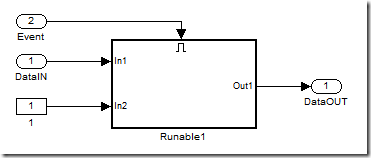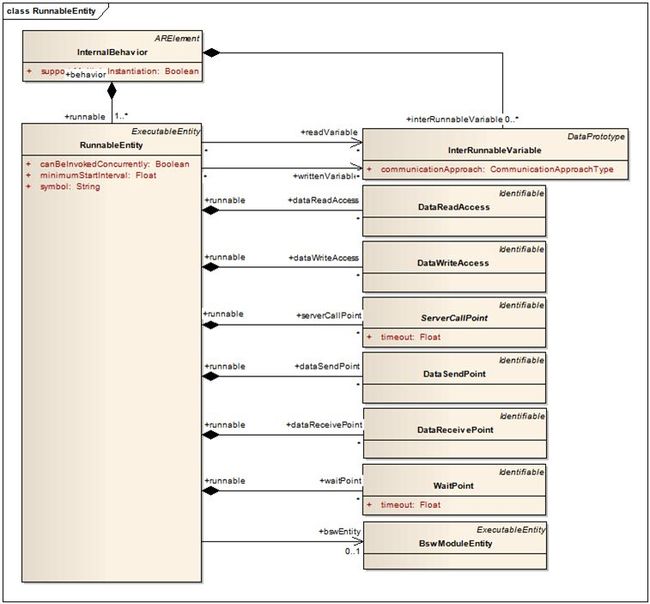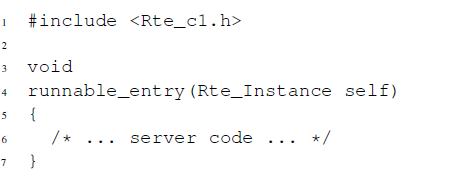AUTOSAR- RTE(2)运行体
本文介绍RTE的运行体。
An AUTOSAR component defines one or more "runnable entities". A runnable entity
is a piece of code with a single entry point and an associate set of data. A softwarecomponent
description provides definitions for each runnable entity within the softwarecomponent.
For components implemented using C or C++ the entry point of a runnable entity is
implemented by a function with global scope defined within a software-component's
source code. The following sections consider the function signature and prototype.
构件内部可以定义一组运行体。每个运行体内部有一个入口和与之关联的数据。
例如:
构件运行体为:
/* Model step function */
void Runnable_Component1 ( void )
{
/* local block i/o variables */
real_T rtb_BufferInput_InsertedFor_Dat;
{
uint8_T rtb_BufferInput_InsertedFor_Eve;
/* SignalConversion: '<Root>/BufferInput_InsertedFor_DataIN_at_outport_0' incorporates:
* Inport: '<Root>/DataIN'
*/
rtb_BufferInput_InsertedFor_Dat =
Rte_IRead_Runnable_Component1_DataINPort_Data();
/* SignalConversion: '<Root>/BufferInput_InsertedFor_Event_at_outport_0' incorporates:
* Inport: '<Root>/Event'
*/
Rte_Read_EventPort_Event ( &rtb_BufferInput_InsertedFor_Eve );
/* Outputs for enable SubSystem: '<Root>/Runable1' incorporates:
* EnablePort: '<S1>/Enable'
*/
if ( rtb_BufferInput_InsertedFor_Eve > 0 )
{
/* S-Function (sfun_autosar_clientop): '<S1>/BSW_ADD' incorporates:
* Constant: '<Root>/1'
*/
Rte_Call_AddPort_Add ( rtb_BufferInput_InsertedFor_Dat, Component1_P._Value,
&Component1_B.BSW_ADD );
}
/* end of Outputs for SubSystem: '<Root>/Runable1' */
/* SignalConversion: '<Root>/BufferOutput_InsertedFor_DataOUT_at_inport_0' */
Rte_Write_DataOutPort_Data ( Component1_B.BSW_ADD );
}
}
使用一个xml描述这个运行体(可以看作是定义阶段所扫描生成的),结构如下:
<RUNNABLE-ENTITY>
<SHORT-NAME>Runnable_Component1</SHORT-NAME>
<CAN-BE-INVOKED-CONCURRENTLY>false</CAN-BE-INVOKED-CONCURRENTLY>
<DATA-READ-ACCESSS>
<DATA-READ-ACCESS>
<SHORT-NAME>IN_DataINPort_Data</SHORT-NAME>
<DATA-ELEMENT-IREF>
<R-PORT-PROTOTYPE-REF DEST="R-PORT-PROTOTYPE">/SWC/Component1/DataINPort</R-PORT-PROTOTYPE-REF>
<DATA-ELEMENT-PROTOTYPE-REF DEST="DATA-ELEMENT-PROTOTYPE">/Component1/if/MathDataInterface/Data</DATA-ELEMENT-PROTOTYPE-REF>
</DATA-ELEMENT-IREF>
</DATA-READ-ACCESS>
</DATA-READ-ACCESSS>
<DATA-RECEIVE-POINTS>
<DATA-RECEIVE-POINT>
<SHORT-NAME>IN_EventPort_Event</SHORT-NAME>
<DATA-ELEMENT-IREF>
<R-PORT-PROTOTYPE-REF DEST="R-PORT-PROTOTYPE">/SWC/Component1/EventPort</R-PORT-PROTOTYPE-REF>
<DATA-ELEMENT-PROTOTYPE-REF DEST="DATA-ELEMENT-PROTOTYPE">/Component1/if/EventInterface/Event</DATA-ELEMENT-PROTOTYPE-REF>
</DATA-ELEMENT-IREF>
</DATA-RECEIVE-POINT>
</DATA-RECEIVE-POINTS>
<DATA-SEND-POINTS>
<DATA-SEND-POINT>
<SHORT-NAME>OUT_DataOutPort_Data</SHORT-NAME>
<DATA-ELEMENT-IREF>
<P-PORT-PROTOTYPE-REF DEST="P-PORT-PROTOTYPE">/SWC/Component1/DataOutPort</P-PORT-PROTOTYPE-REF>
<DATA-ELEMENT-PROTOTYPE-REF DEST="DATA-ELEMENT-PROTOTYPE">/Component1/if/MathDataInterface/Data</DATA-ELEMENT-PROTOTYPE-REF>
</DATA-ELEMENT-IREF>
</DATA-SEND-POINT>
</DATA-SEND-POINTS>
<SERVER-CALL-POINTS>
<SYNCHRONOUS-SERVER-CALL-POINT>
<SHORT-NAME>SC_AddPort_Add</SHORT-NAME>
<OPERATION-IREFS>
<OPERATION-IREF>
<R-PORT-PROTOTYPE-REF DEST="R-PORT-PROTOTYPE">/SWC/Component1/AddPort</R-PORT-PROTOTYPE-REF>
<OPERATION-PROTOTYPE-REF DEST="OPERATION-PROTOTYPE">/BSW/if/BSW_ADD/Add</OPERATION-PROTOTYPE-REF>
</OPERATION-IREF>
</OPERATION-IREFS>
<TIMEOUT>0.000001</TIMEOUT>
</SYNCHRONOUS-SERVER-CALL-POINT>
</SERVER-CALL-POINTS>
<SYMBOL>Runnable_Component1</SYMBOL>
</RUNNABLE-ENTITY>
上面的<SYMBOL>Runnable_Component1</SYMBOL> 提示链接器连接这个符号。
1. 签名(Signature)
The definition of all runnable entities, whatever the RTEEvent that triggers their execution,
follows the same basic form.
[rte sws 1126]
<void|Std_ReturnType> <name>([IN Rte_Instance <instance>], [role parameters])
Where <name> 3 is the symbol describing the runnable's entry point rte sws in 0053.
The definition of the role parameters is defined in Section 5.7.3.
所有运行体,不管是怎样触发,函数定义都是下面这个格式:
<void|Std_ReturnType> <name>([IN Rte_Instance <instance>], [role parameters])
如前面的例子:
void Runnable_Component1(void)
参数的意义为:
IN Rte_Instance <instance> - 本实体的指针,因为一个构件可以多重实例化,所以有时候必须要判断一下自己是哪个实体。
role parameters - 指明是谁触发的这个运行体,有时候一个运行体可以被多个事件触发,需要确定一下自己是哪个事件出发的。
Section 5.2.6.4 contains details on a recommended naming conventions for runnable
entities based on the RTEEvent that triggers the runnable entity. The recommended
naming convention makes explicit the functions that implement runnable entities as well
as clearly associating the runnable entity and the applicable data element or operation.
2. 入口点原型(Entry Point Prototype)
The RTE determines the required role parameters, and hence the prototype of the
entry point, for a runnable entity based on information in the input information (see
Appendix B). The entry point defined in the component source must be compatible
with the parameters passed by the RTE when the runnable entity is triggered by the
RTE and therefore the RTE generator is required to emit a prototype for the function.
[rte sws 1132] The RTE generator shall emit a prototype for the runnable entity's entry
point in the application header file.
RTE通过角色参数判断入口点类型,所以运行体入口必须要定义得复合参数类型,以便于RTE生成函数的触发。
The prototype for a function implementing the entry point of a runnable entity is emitted
for both "RTE Contract" and "RTE Generation" phases. The function name for the
prototype is the runnable entity's entry point. The prototype of the entry point function
includes the runnable entity's instance handle and its role parameters, see Figure 5.2.
[rte sws 1016] The function implementing the entry point of a runnable entity shall
define an instance handle as the first formal parameter.
第一个参数必须是构件实例。
The RTE will ensure that when the runnable entity is triggered the instance handle parameter
indicates the correct component instance. The remaining parameters passed
to the runnable entity depend on the RTEEvent that triggers execution of the runnable
entity.
[rte sws 1130] A function implementing a runnable entity entry point shall only have
the return type Std_ReturnType, if the runnable entity represents a server operation
and the AUTOSAR interface description of that client server communication lists potential
application errors. All other functions implementing a runnable entity entry point
shall have a return type of void.
如果运行体是一个server operation,则返回正确与否,否则返回void。
[rte sws ext 2704] Only the least significant six bit of the return value of a server
runnable shall be used by the application to indicate an error. The upper two bit shall
be zero. See also rte sws 2573.
返回值的最高2为必须是0。


